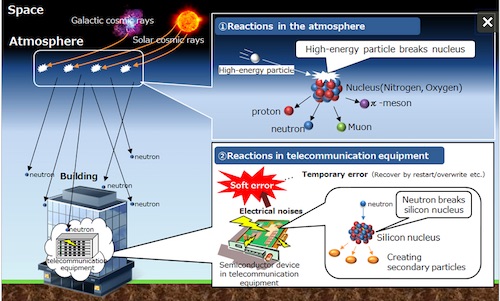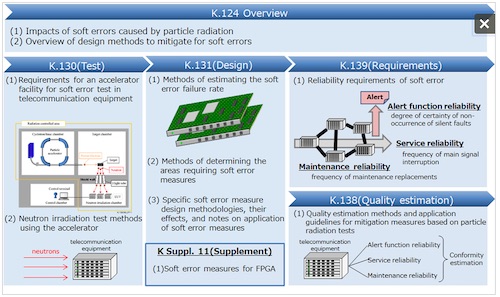|
|
|
|
|
|
| - Enhancing reliability based on Recommendations for design, testing, and quality estimation of measures designed to mitigate soft errors caused by cosmic rays - |
TOKYO, Nov 23, 2018 - (JCN Newswire) - ITU-T, which is a United Nations specialized agency, approved standards about soft errors(1) affecting telecommunication equipment on November 13, 2018. These standards stipulate the design, testing and quality estimation methods and reliability requirements concerning measures designed to mitigate malfunctions (soft errors) in telecommunication equipment on the ground chiefly caused by cosmic rays.
 | | Figure 1: Mechanism of soft error occurrence |
 | | Figure 2: Overview of soft error Recommendations |
To develop these standards, NTT, Fujitsu, Hitachi, NEC, and Oki jointly developed draft Recommendations at "the Ad Hoc Committee on Soft Error Testing (SOET_Adhoc)" formed by TTC, and have driven efforts at ITU-T SG5(2) meetings, with the cooperation of Orange, to have these drafts adopted by ITU-T.
The adopted standards will help to establish networks that are more highly reliable based on the requirements governing measures against soft errors.
Background
In recent years, the number of soft errors caused by cosmic radiation neutrons has been increasing gradually even in telecommunication equipment located on the ground (Figure 1). The soft error disappears as soon as the semiconductor device concerned is restarted or the data concerned are overwritten. Even though a soft error in data can cause a malfunction or system outage, it is difficult to reproduce such a transient error and identify the cause. Since a soft error can have a serious impact on the user, it is a major headache for system operators. Telecommunication equipment is designed so that such malfunctions do not affect network services. However, because soft errors are difficult to reproduce, they were not sufficiently verified at the development stage.
Recently, however, it has become possible to measure the influence of soft errors on telecommunication equipment using a compact accelerator-driven neutron source(3). This measurement makes it possible to determine the influence of soft errors and take preventive measures in advance before vendors sell products and telecommunication carriers introduce telecommunication equipment into operating networks. While it has become possible for carriers to improve network quality dramatically by mitigating soft errors at the stages of equipment development and introduction, there is a need for requirements that serve as the benchmark for methods and evaluation of countermeasure.
http://www.acnnewswire.com/topimg/Low_FujitsuITUTFig1.jpg
Figure 1: Mechanism of soft error occurrence
Recommendations for soft errors in ITU-T
Against this background, at the October 2015 meeting of ITU-T SG5, commencement of a study program on soft errors in telecommunication equipment was approved with the intention of defining requirements on measures against soft errors, ranging from design to evaluation and quality. The SOET_Adhoc member companies worked together and developed draft Recommendations. ITU-T has now approved these Recommendations.
The Recommendations stipulate the design, testing and quality estimation methods and reliability requirements concerning soft errors. They include benchmarks based on which vendors and carriers can select measures against soft errors that are appropriate for the required reliability level.
The soft-error-related standards approved by ITU-T consist of five Recommendations and a supplement. Figure 2 shows an overview of the Recommendations.
http://www.acnnewswire.com/topimg/Low_FujitsuITUTFig2.jpg
Figure 2: Overview of soft error Recommendations
Each Recommendation or supplement defines the following items:
K.124 (Overview) Overview of particle radiation effects(4) on telecommunication systems
(1) Impacts of soft errors caused by particle radiation.
(2) Overview of design methods to mitigate the impacts of soft errors.
K.130 (Test) Neutron irradiation test methods for telecommunication equipment
(1) Requirements for the accelerator facility used to test soft errors in telecommunication equipment
(2) Neutron irradiation test methods that use an accelerator
K.131 (Design) Design methodologies for telecommunication systems applying soft error measures
(1) Methods of estimating the soft error failure rate depending on the devices used and equipment configuration.
(2) Methods of determining the areas requiring soft error measures.
(3) Specific soft error measure design methodologies, their effects, and notes on application of soft error measures.
K Suppl. 11 (Supplement) Soft error measures of field programmable gate arrays
(1) Soft error measure examples for field programmable gate arrays (FPGAs).
K.139 (Requirements) Reliability requirements for telecommunication systems affected by particle radiation
(1) Definitions of standards concerning the frequency of maintenance replacements and the frequency of main signal interruption, and the degree of certainty of non-occurrence of silent faults, due to soft errors.
K.138 (Quality estimation) Quality estimation methods and application guidelines for mitigation measures based on particle radiation tests
(1) Method of determining whether various reliability requirements for telecommunication equipment regarding software defined in K.139 (Requirements) are satisfied or not, based on the results of the neutron irradiation test described in K.130 (Test).
It is expected that widespread deployment of telecommunication equipment that satisfies the requirements defined in these Recommendations will improve the reliability of telecommunication services.
(1) Soft error
Unlike a hard error, which is a fault that causes permanent malfunctioning of a semiconductor device, a soft error is a temporary error that disappears as soon as the semiconductor device concerned is restarted or the data concerned are overwritten.
(2) ITU-T SG5
ITU-T(International Telecommunication Union - Telecommunication Standardization Sector) is an ITU organization that issues Recommendations with a view to standardizing telecommunications.
Study Group 5 (SG5) investigates issues related to the environment and climate change.
(3) Accelerator-driven neutron source
A facility for producing neutrons through a nuclear reaction caused by irradiating the target with protons or electrons that are sped up by an accelerator.
(4) Particle radiation effects
Impact of particle radiation (emitted energy in the form of neutrons, alpha particles, etc.) on semiconductors. In recent years, the number of soft errors in semiconductors caused by neutrons generated in the atmosphere by cosmic rays has been increasing on the ground.
Contact:
NEC
Seiichiro Toda
s-toda@cj.jp.nec.com
+81-3-3798-6511
Hitachi Ltd
Corporate Communications
Tel: +81-3-3258-1111
Topic: Press release summary
Source: Hitachi, Ltd. / NEC Corporation
Sectors: Telecoms, 5G
https://www.acnnewswire.com
From the Asia Corporate News Network
Copyright © 2024 ACN Newswire. All rights reserved. A division of Asia Corporate News Network.
|
|
|
|

|
|
|
| |
| Hitachi, Ltd. Related News |
|
| Friday, 5 April 2024, 17:15 JST |
| Hitachi Energy and SP Energy Networks to boost renewable energy flow |
|
| Friday, 5 April 2024, 17:00 JST |
| Hitachi Selected as "Excellent TCFD Disclosure" by GPIF's External Asset Managers for the Third Consecutive Year |
|
| Tuesday, 26 March 2024, 19:04 JST |
| JFE Steel and Hitachi Jointly Started Providing Solutions for the Steel Industry |
|
| Friday, 22 March 2024, 16:04 JST |
| Hitachi Selected as CDP Supplier Engagement Leader for the Third Consecutive Year |
|
| Tuesday, 19 March 2024, 19:11 JST |
| Hitachi Collaborates with NVIDIA to Accelerate Digital Transformation with Generative AI |
|
| More news >> |
|
|
|